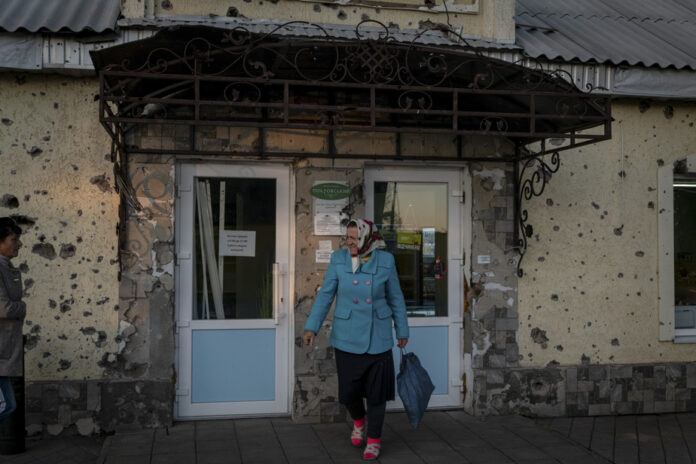When the Russian army approached Kyiv at the start of the invasion last year, the Zavertailo bakery closed shop and prepared free meals for the soldiers defending the city, while continuing to pay its employees. Supplies dried up, interrupted by the heavy fighting around Kyiv, and the bakery ran out of money.
“Everything was closed, we no longer had any income,” says Anna Zavertailo, founder of the bakery. “We had to work hard and for a long time to restart business. »
But it worked. Last spring, Anna Zavertailo opened a second bakery in Kyiv, encouraged by a semblance of a return to normal. The Ukrainian capital gradually adapted to the war and demand returned. “We saw new opportunities,” says Viktoriia Kolomiiets, Zavertailo’s operations director.
The company’s growth is part of a broader, albeit modest, economic recovery in Ukraine. Ukraine’s economic output remains much lower than before the war – the economy contracted by a third after the Russian invasion in 2022 – but it is expected to grow 3.5% this year, estimates the World Bank, thanks to the resumption of domestic spending and financial support from allied countries.
According to economists, returning the Ukrainian economy to pre-war levels will take years and any forecast during wartime is uncertain. Huge challenges loom: rebuilding the country’s devastated cities; growing deficit with the war dragging on; labor shortage caused by the exodus of Ukrainians fleeing the war; mobilization of men of working age to fight.
Nevertheless, after nearly 20 months of war, analysts and business people speak of a sense of resilience and relative stability that is affecting consumer and investor confidence.
“The Ukrainian economy is adapting to the war,” says Olena Bilan, chief economist at Kyiv-based investment bank Dragon Capital. People have moved from “savings mode” to a “more relaxed” state of mind where one can spend more.
A recent World Bank report predicts a 5% rebound in private consumption in Ukraine this year, after it contracted by a quarter in 2022. In cities like Kyiv and Dnipro, far from the fighting but under the threat of Russian air attacks, customers are returning to restaurants and stores.
“Today, Ukrainians understand that the war is likely to be long and that life goes on,” believes Andréiy Chéroukah, CEO of Etnodim, which manufactures vychyvankas, the traditional Ukrainian embroidered shirts. Patriotic fervor has caused sales to triple this year compared to 2022.
People need habits to cope with war, says Olga Koustenko, co-owner of First Point Espresso Bar in Kyiv’s trendy Podil district. Her customers come back because her café is a familiar place to spend time. Demand is high and she opened a second café in the spring.
The unexpected increase in spending is pushing financial institutions to revise their economic forecasts upwards. The International Monetary Fund projects a 2% increase in the country’s total output in 2023. That’s a little less optimistic than the World Bank’s forecast, but it’s much better than the 3% drop announced at the origin.
Certainly, this growth is measured from a very low base, after the Ukrainian economy had been ravaged by a year of war. Notably, the Azovstal steelworks, which accounted for 20% of Ukraine’s steel production, was destroyed when the Russians took Mariupol last year.
Furthermore, the growth rate can also be misleading about a country’s economic health in times of war: production is often boosted by government military orders. Ukraine devotes a large part of its budget to the army and the production of weapons.
But economists say Ukraine’s ability to adapt to the challenges of war helped stabilize the country’s economy. For example, maintaining electricity despite Moscow’s winter campaign against its energy infrastructure.
The opening of new trade routes when Moscow blocked the Black Sea allowed the partial resumption of agricultural exports (the bulk of Ukraine’s income before the war), notes Maria Repko, deputy director of the Center for Economic Strategy, at Kyiv.
The World Bank estimates that Ukraine’s exports will decline again this year before increasing by 15% in 2024 and 30% in 2025, good economic news if the war drags on.
Like Russia, Ukraine is restructuring its economy based on the war. The total Ukrainian budget will be 46 billion in 2024, and more than half will be spent on defense.
But tax revenues are well below these expenses and the budget deficit will reach 21% of GDP, predicts Finance Minister Denys Chmyhal, who says Ukraine will need 42 billion in foreign aid.
This amount will be difficult to raise. Support for Ukraine is fading in the United States, and the world’s attention is turning to Israel and Gaza. “It’s very worrying,” says Maria Repko.















